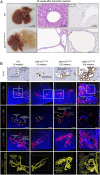JNK signaling prevents biliary cyst formation through a CASPASE-8-dependent function of RIPK1 during aging
- PMID: 33798093
- PMCID: PMC8000530
- DOI: 10.1073/pnas.2007194118
JNK signaling prevents biliary cyst formation through a CASPASE-8-dependent function of RIPK1 during aging
Abstract
The c-Jun N-terminal kinase (JNK) signaling pathway mediates adaptation to stress signals and has been associated with cell death, cell proliferation, and malignant transformation in the liver. However, up to now, its function was experimentally studied mainly in young mice. By generating mice with combined conditional ablation of Jnk1 and Jnk2 in liver parenchymal cells (LPCs) (JNK1/2LPC-KO mice; KO, knockout), we unraveled a function of the JNK pathway in the regulation of liver homeostasis during aging. Aging JNK1/2LPC-KO mice spontaneously developed large biliary cysts that originated from the biliary cell compartment. Mechanistically, we could show that cyst formation in livers of JNK1/2LPC-KO mice was dependent on receptor-interacting protein kinase 1 (RIPK1), a known regulator of cell survival, apoptosis, and necroptosis. In line with this, we showed that RIPK1 was overexpressed in the human cyst epithelium of a subset of patients with polycystic liver disease. Collectively, these data reveal a functional interaction between JNK signaling and RIPK1 in age-related progressive cyst development. Thus, they provide a functional linkage between stress adaptation and programmed cell death (PCD) in the maintenance of liver homeostasis during aging.
Keywords: MK2; cholangiocytes; liver; liver cysts; programmed cell death.
Copyright © 2021 the Author(s). Published by PNAS.
Conflict of interest statement
The authors declare no competing interest.
Figures







Similar articles
-
RIPK1 and death receptor signaling drive biliary damage and early liver tumorigenesis in mice with chronic hepatobiliary injury.Cell Death Differ. 2019 Dec;26(12):2710-2726. doi: 10.1038/s41418-019-0330-9. Epub 2019 Apr 15. Cell Death Differ. 2019. PMID: 30988397 Free PMC article.
-
c-Jun N-terminal kinases differentially regulate TNF- and TLRs-mediated necroptosis through their kinase-dependent and -independent activities.Cell Death Dis. 2018 Nov 15;9(12):1140. doi: 10.1038/s41419-018-1189-2. Cell Death Dis. 2018. PMID: 30442927 Free PMC article.
-
Interaction of RIPK1 and A20 modulates MAPK signaling in murine acetaminophen toxicity.J Biol Chem. 2021 Jan-Jun;296:100300. doi: 10.1016/j.jbc.2021.100300. Epub 2021 Jan 16. J Biol Chem. 2021. PMID: 33460648 Free PMC article.
-
Necroptosis in development, inflammation and disease.Nat Rev Mol Cell Biol. 2017 Feb;18(2):127-136. doi: 10.1038/nrm.2016.149. Epub 2016 Dec 21. Nat Rev Mol Cell Biol. 2017. PMID: 27999438 Review.
-
The Receptor Interacting Protein Kinases in the Liver.Semin Liver Dis. 2018 Feb;38(1):73-86. doi: 10.1055/s-0038-1629924. Epub 2018 Feb 22. Semin Liver Dis. 2018. PMID: 29471568 Free PMC article. Review.
Cited by
-
Genetics, pathobiology and therapeutic opportunities of polycystic liver disease.Nat Rev Gastroenterol Hepatol. 2022 Sep;19(9):585-604. doi: 10.1038/s41575-022-00617-7. Epub 2022 May 13. Nat Rev Gastroenterol Hepatol. 2022. PMID: 35562534 Review.
-
Canagliflozin Delays Aging of HUVECs Induced by Palmitic Acid via the ROS/p38/JNK Pathway.Antioxidants (Basel). 2023 Mar 30;12(4):838. doi: 10.3390/antiox12040838. Antioxidants (Basel). 2023. PMID: 37107212 Free PMC article.
-
c-Jun N-terminal kinase (JNK) signaling contributes to cystic burden in polycystic kidney disease.PLoS Genet. 2021 Dec 28;17(12):e1009711. doi: 10.1371/journal.pgen.1009711. eCollection 2021 Dec. PLoS Genet. 2021. PMID: 34962918 Free PMC article.
-
Activation of the Unfolded Protein Response (UPR) Is Associated with Cholangiocellular Injury, Fibrosis and Carcinogenesis in an Experimental Model of Fibropolycystic Liver Disease.Cancers (Basel). 2021 Dec 24;14(1):78. doi: 10.3390/cancers14010078. Cancers (Basel). 2021. PMID: 35008241 Free PMC article.
References
-
- Kuan C. Y., et al. ., The Jnk1 and Jnk2 protein kinases are required for regional specific apoptosis during early brain development. Neuron 22, 667–676 (1999). - PubMed
Publication types
MeSH terms
Substances
Supplementary concepts
Grants and funding
LinkOut - more resources
Full Text Sources
Other Literature Sources
Medical
Molecular Biology Databases
Research Materials
Miscellaneous

